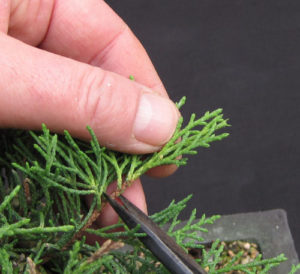/
Bonsai are pruned on a regular basis so they keep their diminutive size. Without pruning, their natural apically dominant growth habit will take over; the upper and outer branches and shoots will extend strongly at the expense of the inner and lower growth, that could eventually dieback.
Without the restriction at the roots in the confines of a bonsai pot, the tree would theoretically grow to a natural height.
It is therefore important that growth is restrained. Unpruned upper branches can quickly lose their taper and delicacy, and in time, can become coarse and too thick for their position at the top of the trunk.
However, there is a balance that must be struck. A bonsai must be allowed to grow. New growth is not only a sign of a healthy plant (and therefore a healthy bonsai) but in turn it generates a refreshing of the tree’s structure, new root growth and vitality. Therefore a bonsai must be allowed periods of growth, periods of time where it is allowed to grow; enough to revitalise its energy but not so much that growth becomes coarse or the shape of the tree is completely lost and apical dominance is allowed to take over.
A bonsai that is continually trimmed without respite will be continually regenerating new buds and shoots; the repeated production of these new buds deplete the energy reserves of a tree when it is unable to recoup its lost energy levels by means of photosynthesis.
It must be realised that it is a myth to think that bonsai should and must be trimmed on a daily or weekly basis. It is also a myth to think that great bonsai look perfect all year round. Most bonsai are exhibited, photographed and displayed in perfect condition but this state is only temporary.
These same trees are allowed (or should be allowed) periods of the necessary free growth to allow shoot extension and therefore re-energise the tree; the perfect image is temporarily lost.
A balance must be struck. Free, unrestricted growth will result in the loss of refinement, shape and taper but this only happens after a certain amount of time (largely dependant on the vigour of individual tree species and individual trees). Allowing new growth does no damage to the bonsai, its shape or refinement. Any well-developed bonsai can easily be trimmed back to shape even after 3 or 4 months (or in many cases even longer) free growth, whichever tree species they are.
The practicalities of allowing growth or not continually pruning your bonsai
It is very easy to fall into the trap of continually trimming and pinching new growth throughout the growing season; particularly for enthusiastic beginners with smaller collections. However, it is far better to get into a habit of allowing new shoots to extend before trimming back the new shoots after they have hardened off. (The shoot becomes woody).
As a failsafe, it is worth trimming back any new vigorous a shoot in the upper branches before this time to ensure that there is no over-thickening in this area but otherwise, middle and lower branches can be left to extend.
As well as keeping the tree in good health and vigour, when the new growth is finally pruned back, the branches will create new buds and shoots along the length of the branch rather than just clusters of leaves that would otherwise be prompted at the very tips of regularly trimmed branches.
During dormancy in the Winter, don’t just trim the tree to your ideal shape/silhouette. Any further growth the following year will need removing to bring the branches back to within your ideal silhouette.
Instead during the late Winter, prune the branching back hard so that the new growth can grow outwards, toward the silhouette of the tree. Again, removing the necessity to remove so much of the new, fine growth of the following season.
Knowing exactly how much new growth to allow, how hard to prune back in the Winter to allow new shoots to extend the following year and exactly how often to prune during the Spring and Summer is difficult to anticipate for the beginner and for experienced enthusiasts using an unfamiliar species. Much of this knowledge is gained from experience. However, the most important point is to understand the need for you to allow your bonsai to grow.




